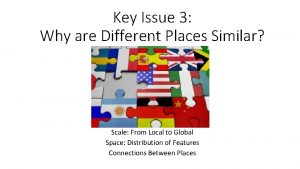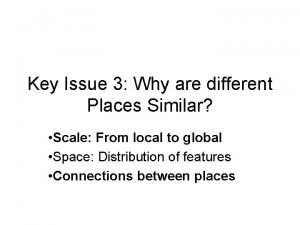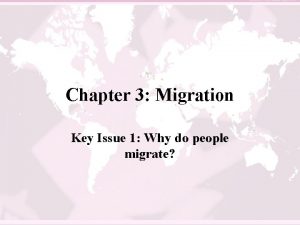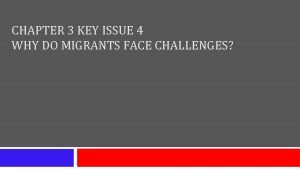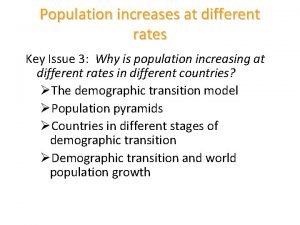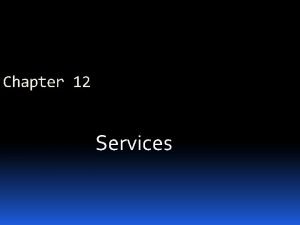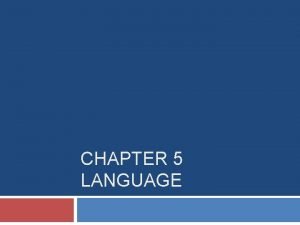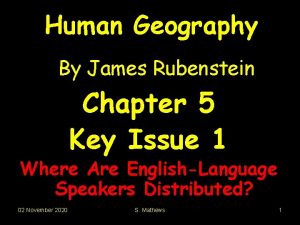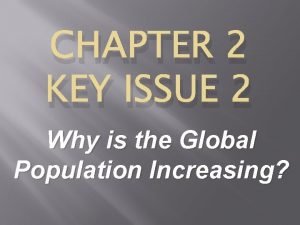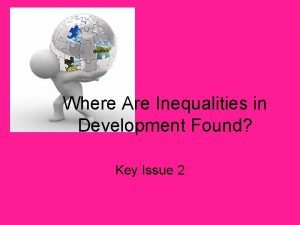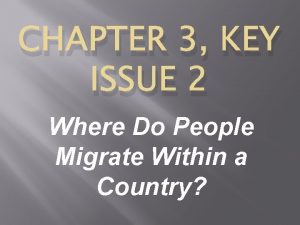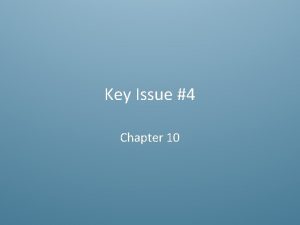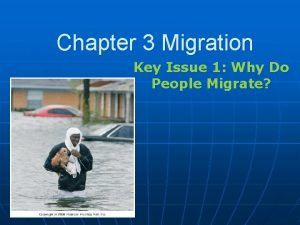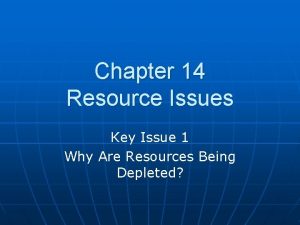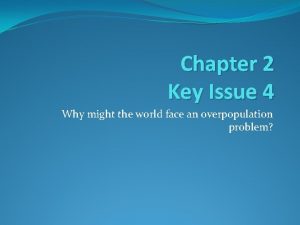CHAPTER 4 KEY ISSUE 3 Why is Access






















































- Slides: 54

CHAPTER 4 KEY ISSUE 3 Why is Access to Folk and Popular Culture

IMPORTANT FOR TODAY – POPULAR culture’s main mode of diffusion is HEIRARCHICAL.

ELECTRONIC MEDIA is responsible for the wide diffusion of POPULAR culture throughout the world.

This technology is a rapid agent for diffusion of culture across the Folk-Popular divide. By accessing such media, people in FOLK settings can be exposed to the tenets of current POPULAR culture.

At the same time, elements of FOLK culture can become POPULAR by being diffused through electronic media.



Principal obstacle to accessing popular culture is lack of access to electronic media. �Lack of $$$ for electronics (TV, Computer) �Restrictions on Media some countries in



Most important media format to spread popular culture is TV. Watching TV is most popular leisure activity in the world. - Global viewer - 3 hrs per day - Average AMERICAN - nearly 5 hrs per day (4. 6).

Americans enjoy, on average, about 7 hours of real leisure time per weekend. How do they spend it?

ORIGIN of TELEVISON th �Early 20 century: TV technology originates in multiple hearths – USA, USSR, France, Japan, UK, Germany…

Early BRITISH television Early FRENCH Television Early JAPANESE television

DIFFUSION of TV • With its booming postwar economy, the UNITED STATES embraced the television like no other country could. • While most other countries were shattered by war, the US middle class was flush with disposable income.

By 1954, the US had 86% of the television sets in the world.

Only Canada and the UK could remotely compete!


As the developed world recovered from Still, a television deep division existed WWII ownership betweenskyrocketed the developed and • by 1970 , American share of TVs had developing world. fallen to 25%.

Since the 1980 s, the price of a television set has decreased significantly. With each new ‘generation, ’ older sets become less expensive and more accessible to those in developing countries.

TV followed a hierarchical diffusion pattern, from the most developed to the least developed parts of the world.

Diffusion of the Internet: The New Millennium Diffusion of the internet follows pattern established by TV but at a MUCH FASTER RATE. In 1995, the United States accounted for 57% of global internet users. By 2011, US users accounted for only 10% of global internet


Diffusion of Social Media: Twenty-First Century Same diffusion pattern as TV and Internet – ONLY EVEN


Facebook • 2006: Facebook users in United States consisted of more than 50% of global users. • 2011: global share decreased to less than


In 2012, the US celebrities accounted for 19/20 of the ‘most followed’ Twitter accounts.

You. Tube might be in the mid-stage of the familiar model. Will the developing world embrace it?

CULTURE WARS INTERNAL and EXTERNAL THREATS to FOLK CULTURE posed by ELECTRONIC MEDIA

EXTERNAL THREAT: WESTERN MEDIA DOMINANCE

People in the developing world who embrace folk culture might feel challenged by electronic media and its diffusion of popular culture. • Some governments and leaders fear the effect of these messages on their people.

DISTRUST OF WESTERN MEDIA All 25 of the biggest broadcasting companies are from the West. Leaders of developing countries could view this dominance as imposing American/western values: � Upward social mobility � Expanded roles for women � Empowerment of youth � Embracing diversity

POLICING The NEWS Many African and Asian government officials criticize freedom of the press in the United States. To ‘counter’ Western media, many countries in Africa and some in Asia have state-run news agencies, which project a gov’tsponsored POV.

A North Korean man in Pyongyang receives the news from a gov’t run news station. All international media outlets are banned and blocked in North Korea.

Run from this Moscow building, TASS was the official news wing of the Soviet government; all other news outlets were banned.

Limiting Access to TV • Aside from running their own stations, some gov’ts ban or block certain stations. • Satellite dishes enable wide and unrestricted access • Their signal can’t be blocked • They can be removed/hidden


People in Nigeria watching a collectively-owned satellite TV

Satellite dishes in Damascus, Syria- allow residents to bypass state-run TV networks

Internal Threat: Social Media Some governments attempt to limit Internet content, including: 1. Political Content �Opposition to government policies 2. Social Content �Socially sensitive material, such as gambling or sex, ‘inappropriate’ examples 3. Conflict and Security Content �Armed conflict, border disputes, or militant groups 4. Internet Tools �Email, Internet hosting, and Internet searches


CENSORSHIP AND RESPONSE (CASE STUDIES)

Complicated Memory of Tiananmen Square In 1989, thousands of pro-democracy students flooded into Beijing, demanding reforms to the communist system.

The protests were violently dispersed by the military authorities.

These events caught Western media attention and were widely broadcasted, shaming the Chinese authorities

“Tankman”

How has the GREAT FIREWALL impacted memories of TIANANMEN?

The ARAB SPRING and Social Media

In 2011, countries throughout the Arab world ignited in revolution against corrupt leaders. • Frightened leaders shut down traditional media, like TV and radio, but they couldn’t control SOCIAL MEDIA. Protests spread, driven by posts and tweets that allowed protesters to organize. • Cell phone cameras allowed protesters to broadcast their experiences to the world.




Modern tech- social media, smartphones, live feeds- have allowed for the rise of the CITIZEN JOURNALIST, a growing force which is extremely hard to control. Citizen journalists report views ‘from the ground’ that traditional media often does not convey.
 Pictures
Pictures Why are situation and site factors important
Why are situation and site factors important Why do services cluster downtown
Why do services cluster downtown Why are downtowns distinctive
Why are downtowns distinctive Key issue 4 why do countries face obstacles to development
Key issue 4 why do countries face obstacles to development Key issue 3 why do individual languages vary among places
Key issue 3 why do individual languages vary among places Key issue 4: why do people preserve local languages?
Key issue 4: why do people preserve local languages? Key issue 3 why do people migrate
Key issue 3 why do people migrate Why are different places similar geography
Why are different places similar geography Why are places similar
Why are places similar Chapter 3 key issue 1
Chapter 3 key issue 1 Key issue 4 why do migrants face obstacles
Key issue 4 why do migrants face obstacles Key issue 4 why do migrants face obstacles
Key issue 4 why do migrants face obstacles Key issue 3 why do some places face health challenges
Key issue 3 why do some places face health challenges Key issue 4 why are some human actions not sustainable
Key issue 4 why are some human actions not sustainable Key issue 3 why does population growth vary among regions
Key issue 3 why does population growth vary among regions Key issue 4 why are some actions not sustainable
Key issue 4 why are some actions not sustainable Chapter 13 key issue 1
Chapter 13 key issue 1 Key issue 1 where are services distributed
Key issue 1 where are services distributed Chapter 12 key issue 4
Chapter 12 key issue 4 Chapter 11 key issue 4
Chapter 11 key issue 4 Chapter 5 key issue 1
Chapter 5 key issue 1 Chapter 5 key issue 4
Chapter 5 key issue 4 Chapter 4 key issue 3
Chapter 4 key issue 3 Chapter 13 key issue 4
Chapter 13 key issue 4 Chapter 12 key issue 2
Chapter 12 key issue 2 Received pronunciation definition ap human geography
Received pronunciation definition ap human geography Chapter 6 key issue 4
Chapter 6 key issue 4 Chapter 5 key issue 2
Chapter 5 key issue 2 Chapter 4 key issue 2
Chapter 4 key issue 2 Chapter 2 key issue 2
Chapter 2 key issue 2 Chapter 2 key issue 1
Chapter 2 key issue 1 Bulk-gaining
Bulk-gaining Don't ask why why why
Don't ask why why why Key partners business model canvas example
Key partners business model canvas example Key partners
Key partners Why did the sale of indulgences become a critical issue
Why did the sale of indulgences become a critical issue What is fair trade coffee why is it an ethical issue
What is fair trade coffee why is it an ethical issue Terminal access controller access-control system
Terminal access controller access-control system Terminal access controller access-control system
Terminal access controller access-control system Key issue 2 where are inequalities in development found
Key issue 2 where are inequalities in development found Key issue 1 where did agriculture originate
Key issue 1 where did agriculture originate Key issue 1 where are languages distributed
Key issue 1 where are languages distributed Key issue 2: where do people migrate within a country?
Key issue 2: where do people migrate within a country? Thinking geographically key issue 1
Thinking geographically key issue 1 Key issue 4
Key issue 4 Hearth of islam
Hearth of islam Why is access to folk and popular culture unequal
Why is access to folk and popular culture unequal Chapter 11 assessment chemistry
Chapter 11 assessment chemistry Means and extremes of proportions
Means and extremes of proportions 7 ionic and metallic bonding
7 ionic and metallic bonding Chapter 9 surface water chapter assessment answer key
Chapter 9 surface water chapter assessment answer key Chapter 7 ionic and metallic bonding chapter answer key
Chapter 7 ionic and metallic bonding chapter answer key Population ecology section 1 population dynamics answer key
Population ecology section 1 population dynamics answer key Why-why analysis
Why-why analysis








